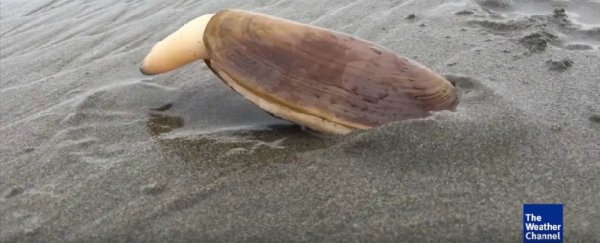On Wednesday, the Weather Channel posted a video of a digging clam to its Facebook page with the caption, "This bizarre video of a clam digging in sand has gone viral." Never has an invertebrate prophecy been so self-fulfilling.
The digging clam wracked up about 5 million views and counting. Commenters took to the clam with gusto, debating what sort of bivalve it was, with most camps arguing for either geoduck or razor clam.
It is indeed a razor clam, as Annette Hosoi, a professor of mechanical engineering at the Massachusetts Institute of Technology (MIT) told The Washington Post.
Mechanical engineers find razor clams to be particularly appealing objects of study because, despite a lack of hands or claws, the bivalves can burrow through sand to a depth of 0.6 metres (2 feet).
"If you only have a shell that you can open one way, how do you dig?" Hosoi pointed out.
And looking purely at their muscle strength, the razor clam should be able to scoot only a few centimetres under soil.
But work from Hosoi and graduate student Amos Winter demonstrated that the clams can turn solid sand into what is something like quicksand, a process that researchers describe as "fluidising".
To observe the way the clams dig, Winter constructed a habitat out of the panes of glass in an ant farm. The researchers filled the farm with little transparent beads and watched the clam dig, as they reported in 2012 in the Journal of Experimental Biology.
"It has a really interesting strategy for digging," Hosoi said.
First a clam relaxes its muscles, which causes the shell to open. (In the same way that the mussels we eat pop open when cooked, except these razor clams aren't relaxed all the way dead.)
Braced in the sand, the clam thrusts its fleshy foot downward.
Then it squeezes water into the bottom of its foot, causing the appendage to balloon. So anchored, the clam contracts. The pocket of sand around the clam "fluidises", loosening up and reducing the drag on the clam, so the shell can slide down to the foot.
The clam repeats these steps. They're speedy at it, too. Winter, now a professor at MIT, calls the razor clam the "Ferrari of bivalves", Hosoi said.
The bit we see at the end - spoilers, it's gross - isn't part of the dig cycle.
"That's just the clam expelling the junk in its system," the mechanical engineer said.
Based on this behavior, Hosoi, Winter and their colleagues created a device called the RoboClam.
Robotics companies with underwater autonomous vehicles need a lightweight way to anchor in sandy soil, particularly around corals (where a heavy anchor might cause damage). The RoboClam mimics the razor clam's digging ability, allowing an object to secure itself to the sea floor.
Hosoi also envisions RoboClam technology being useful for depositing undersea cables.
Close to shore, it's not possible for boats to lay cables in the typical method, using deep-sea sleds. Instead, human divers have the difficult and dangerous task of physically burying the lines.
But robotic clam-like diggers attached to the cables would be able to do this job well, Hosoi said, and more cheaply, too.
"It's an application that's just crying out for this technology," she said.
2017 © The Washington Post
This article was originally published by The Washington Post.
